
Growing Up Fast
COVID as the Spark for a Telehealth Revolution
Estimated Read Time: 4 - 5 Minutes
As the world knows, COVID-19 made transformative waves across all industries from recreation to retail to restaurants. Businesses were compelled to reevaluate and restructure their business models to remain relevant in a profoundly uncertain future. Fortunately, the healthcare sector was already on the path to adapt to the evolving landscape, facing competition from alternative healthcare providers over the past decade.1 Amid this backdrop, the rise of telehealth emerged as a transformative solution perfectly suited to the pandemic era.
Though telehealth has been around for some time (it truly began in the 1960s with psychiatric consultations), it had been slow to gain traction among healthcare providers. COVID-19, however, changed that; the pandemic aggressively accelerated telehealth adoption, making it the de facto model for routine, chronic, and primary care visits for now and years to come. 2020 pushed telehealth to overcome years of industry resistance and delayed acceptance from consumers and physicians alike. Virtual care visits accounted for 69% of total medical appointments2 at the height of the pandemic in April, and it remained well above pre-pandemic levels as the country eased restrictions. And when taking a look at the statistics, we would venture to say that telehealth’s foray into the spotlight has been nothing less than triumphant.

A Star is Born
In a time when shoppers were scared to go to their local grocery store for household essentials, telehealth emerged as a contact-free alternative warmly embraced by the public. A survey conducted in May of this year showed that 72% of telehealth users had their first-ever virtual health visit during the pandemic with an overwhelmingly positive reaction. A remarkable 75% of consumers reported high levels of satisfaction with their experience using the service. Moreover, 80% found telehealth very easy to use, and 70% would recommend it to a friend.3 Those who elected to use telehealth services loved the added convenience, increased safety, and speed of access offered by virtual visits. These features were so enticing that 50% of users expressed their willingness to switch providers to utilize telehealth options regularly. The demand for virtual healthcare options is undeniably on the rise, as consumers recognize its long-term benefits. However, with this industry upheaval, we have to ask, will this upturn in telehealth adoption prove to be sustainable in the future?

The Next Stage
Despite the fact that telehealth utilization is above previous levels of use, virtual health visits now represent just 21% of total encounters as consumers open up to physical visits and postponed examinations.4 It is clear that a plateau is in progress, but that doesn’t necessarily mean that virtual health acceptance is on the decline. Much like the “gold rush” energy and the enthusiasm brought on by the dot-com boom in the ‘90s, a dose of reality is starting to be administered. Similar to the impact of eCommerce on the retail industry, we have come to realize that the true power lies in a hybrid model encompassing digital, physical, and personalized experiences across all sectors. The primary challenge for healthcare providers is to harmonize all three aspects.

We realize that virtual visits can be excellent in treating some conditions and in some specialties, but they are not a one-size-fits-all solution. After all, we are talking about the human body; close physical examination, use of tests, and utilization of instruments are sometimes necessary to provide proper care. Because of this, physicians have reported that they are concerned with their ability to use patient cues, their own senses, and personal patient relationships in virtual care settings. They feel that telehealth is perfect for routine, repetitive, and check-in services, but that more complex care may require a nuanced approach.
COVID-19 has contributed to a discourse that foresees a shift away from inpatient care towards home-based healthcare for improved outcomes and cost savings. A “hospital at home” model looks very different from the traditional in-person healthcare setting. Consequently, virtual care will need to evolve to serve as the gateway for care, bridging the gap between primary care, home health, and the collaboration of various specialists and providers.
An Evolved Future
While many consumers today equate virtual care visits with Zoom calls or other video conferencing tools, the real advancement in the telehealth space moves beyond second-party platforms to create an interconnected set of technologies, people, and places where virtual health is a distinct component of the healthcare ecosystem. Even patient communications can extend beyond scheduled visits to include emails, text messages, digitally shared records, photo sharing, and more, to promote a more continuous stream of vital communications between consumers and providers. As home health services bring the primary care office to your front door, these virtual tools will grow in importance for physicians and specialists. The prevalence of wearable digital technology, remote monitoring devices, sensors, and AI will further provide an essential data flow, providing continuous intelligence that will enable physicians to keep people well and allowing them to intervene as required through notifications or virtual visit requests.

It has become evident that COVID-inspired virtual health has provided the impetus needed to look beyond traditional care models, and it is only the beginning of an exciting new era of a health and wellness relationship model. Creating that model, though, will require the industry to start with the consumer and map the ecosystem around their needs. Above all, healthcare will need to innovate new ways to seamlessly create effective and efficient health experiences both digitally and physically, for today and the future beyond the pandemic.

Learn more about how WD can help innovate and scale your practice and then talk with our Health and Wellness practice leader, Dan Stanek, to get started.

 Dan Stanek
Dan Stanek


